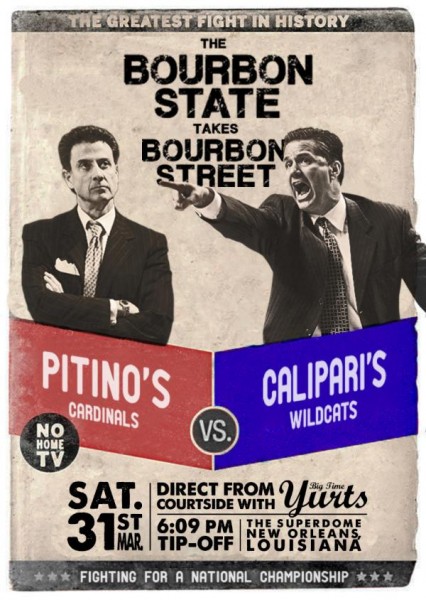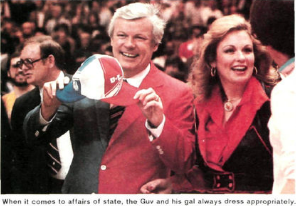Deconstructing the Louisville-Kentucky Rivalry to the Rest of America
Posted by rtmsf on March 27th, 2012So we hear that there’s an interesting rivalry game going down in New Orleans on Saturday. It’s a good thing that nobody has decided to write about it or talk about it yet; that means this piece will be first on the scene.
All kidding aside, Dream Game II will without question be the most-watched event in the Commonwealth of Kentucky’s history. While the Kentucky Derby may get more worldwide attention, the truth is that most Kentuckians don’t know any more about the Sport of Kings than they do about navigating the New York City subway system — the first Saturday in May is mostly viewed as a neat aside for the state to put on its happy face and throw a grandiose party. But as far as college basketball, this is a sophisticated crowd whose knowledge and passion cuts through all the cultural, class and racial fissures that exist in any modern society. And this rivalry between Louisville and Kentucky exhibits that perhaps better than any other such local tussle in the sport — let’s look at the reasons why.
- The Good Folks of Kentucky Are Bats#!t Crazy About College Basketball. We very much mean this in a complimentary way. Take a normal August, for example. While the rest of the nation is caught up in pennant races, backyard barbecues, and the imminent start of college football and the NFL, Wildcat and Cardinal fans are calling into local talk shows and signing on to message boards to discuss the latest word from summer pick-up games and recruiting rumors. When Rick Pitino went through his 15 seconds of fame several summers ago, the coverage of Karen Sypher and the entire debacle saturated both Lexington and Louisville news media for weeks. It’s no secret that college hoops is a 365-day per year commitment in the Commonwealth, and such near-obsession with the sport magnifies the importance of the standing of the two major programs on a regular basis.
- UK Fans Are Not Over Pitino’s Return to the State. And they never will be. What you have to realize is that from 1989-97, Rick Pitino as the young, brash and highly successful coach of the Wildcats was as big as big gets in the Bluegrass. Not only did he resurrect the Kentucky program from the very public shame of a devastating probation, but he captured hearts and minds from Paducah to Pikeville with his intoxicating and fun style of basketball featuring three-point shooting, full-court pressure defense and a deep, active bench. When he left for the Boston Celtics in 1997 after three Final Four appearances and a national title in 1996, most UK fans were sad but thankful for how he had rebuilt their proud program. That all changed four years later after Denny Crum’s retirement when he returned to take over the head job at Louisville. Suddenly those same fans who had adored the charismatic coach in Lexington looked at his return as nothing other than a traitorous Judas Iscariot. The thinking went: “Out of all the good D-I coaching jobs in America, he had to choose Louisville?” Can you blame them?
- Dark and Bloody Hardwood. As a historical footnote, Kentucky and Louisville didn’t play from 1959 to 1983 because Adolph Rupp and his successor, Joe B. Hall, did not see the value in giving Denny Crum’s burgeoning program the platform (the logic being, UK is already top dog in the state, why give the Cards a chance to beat us and encroach on our large and loyal fan base?). The NCAA Tournament ended the drought after 24 years by pitting the Wildcats and Cards together in Knoxville, Tennessee, in the ’83 regional finals. After a close game headed to overtime, Louisville won the trip to the Final Four on that day, and afterward, the Kentucky legislature pressured the two schools separated by only 75 miles into meeting annually on the hardwood, which they’ve done 30 times since (UK has won 20 of those games). The series has had its ups and downs over the intervening three decades, but neither school has won more than four in a row and that was done only once (Kentucky, 1990-93).
- John Calipari and Rick Pitino Do Not Trade Christmas Cards. Long before the two head coaches worked and resided in the same state, they were rivals going back to the days of Kentucky and Massachusetts. The two brash young coaches met in a heated regional semifinal game in 1992 (the game before “The Game”) where UMass had stormed back on Kentucky from down 21 points when a referee called a coaching box technical foul on Calipari. A two-point game with six minutes to go suddenly swung to a six-point UK lead where the Wildcats were able to advance to meet Duke two nights later. Calipari believed at the time that Pitino had goaded Lenny Wirtz into making that call. The rivalry continued on through the 1996 season, when UMass and Kentucky traded positions at the #1 spot in the polls, with the Minutemen enjoying a Great Eight win early in the season before the Wildcats defeated them in the far-more-important Final Four. With both coaches later finding NBA refuge in Conference USA (Calipari at Memphis in 2000; Pitino at Louisville in 2001), the rivalry began anew, only to have the stakes raised even higher when Cal headed north to take over the helm in Lexington three years ago. Believe nothing of the platitudes you hear from their mouths this week — these two gentlemen would like nothing more than to beat the other with all the stakes on the line.
- Dream Game II Makes This Rivalry Nationally Relevant Again. Rivalries in college sports are generally very local in nature. The best of them are in situations where fans of the rival schools have to live, work, and play in the same cramped geographic space with the other. Obviously, Kentucky-Louisville, Kansas-Missouri, and Indiana-Purdue, among several others, have long been in the conversation for the best of the bunch. But what has set Duke and North Carolina apart from the rest for the better part of three decades has been the long-term quality of the teams in the rivalry. Both Triangle schools are regularly in the national top 10 and on the short list of teams competing for national titles (20 Final Four appearances in the last 30 years). Of course we realize that at the local level, the rivalry involving Kentucky and Louisville feels like the biggest thing on the planet. But for far too many of these Wildcats-Cardinals battles, nobody outside of the Bluegrass has cared about it because only one school (usually UK, but occasionally Louisville) was nationally relevant at the time. This year’s regular season meeting was the first time both squads had been top-five teams at the same time, and now they’ll meet again as participants in the Final Four. There’s no doubting the national significance of their two rivalry games this year, and we’re as excited as anybody else to see the Cards and Cats tip it off in New Orleans on Saturday night. And you know what — so are the guys watching in Portland, Miami, and everywhere in-between. That’s what you call relevance.













































